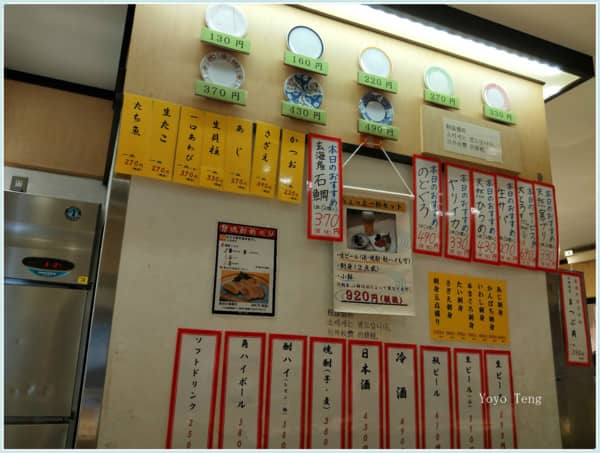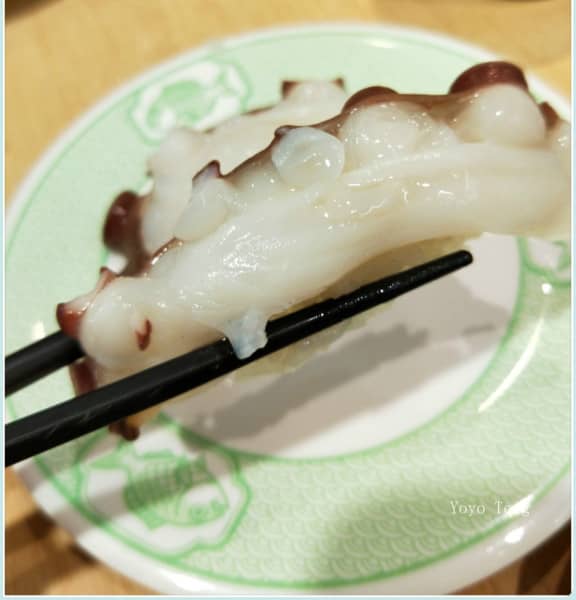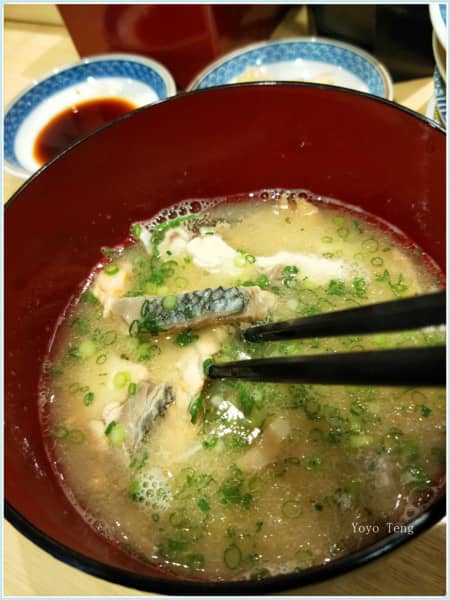Tonight, I checked into an excellent hotel conveniently close to Hakata Station. After accompanying my friend on a shopping spree at Daiso, we headed directly across to the Hakata Station for dinner. As we strolled along, something caught our eye: a bustling conveyor belt sushi joint called “魚がし” (Uogashi).

Fukuoka, the bustling metropolitan hub of Kyushu, has surprisingly drawn me in three times within half a year. It undoubtedly possesses its own allure. While it may not rival Tokyo’s modernity and glamour, life here is easygoing and stress-free. The real highlight lies in the concentrated culinary and shopping delights.

Descending into the underground streets of Hakata Station, you’ll find a gastronomic treasure trove—the crème de la crème of Fukuoka’s delicacies.

It was unmistakably the most popular sushi spot in the lively Hakata Station food street. The queue of eager diners spoke volumes about its reputation!

The entire food street revolves around this particular establishment, and I stood outside the door for a full half-hour before finally securing a seat. Originally planning to indulge in Daisen’s famous beef motsunabe, I swiftly changed course to savor the fresh, market-to-table sushi from this acclaimed Fukuoka must-try spot!

Inside the restaurant, various sushi options are categorized by plate color, clearly marked on the wall. Price ranges include an average of 130 to 490 yen per plate, with the value set menu at 920 yen and the deluxe maguro assortment meal at 1,550 yen.

When you’re in Japan and craving sushi, just go ahead and order a mixed sushi platter—it’s convenient and perfect for takeout! Especially, let me tell you about my last experience: I hopped on the Shinkansen for a whole hour to get to Kumamoto. But before that journey, I grabbed a generous portion of sushi to-go. And let me tell you, munching on that sushi feast during the train ride was pure satisfaction!

When it comes to sushi, ordering directly from the sushi chef while sitting at the counter in the restaurant is where the real fun begins!

Personally, I prefer nigiri sushi—I find that the raw fish perfectly complements the sweet flavor of the rice. When it comes to sushi, the Japanese often start with lighter flavors. So, for my first plate, I went straight for the crispy, fresh akagai (ark shell) nigiri.

赤貝~あかがい(akagai)
To savor these two plump and succulent akagai (ark shell) is a rare treat—unless you’re in Japan, where their freshness is unparalleled.

ほたてがい Hotategai 生干貝
When it comes to freshness, Fukuoka has a distinct advantage—it’s right by the sea. So, sourcing fresh seafood here is a breeze. Ingredients like live scallops exemplify this freshness. Whether a delicacy tastes exquisite or lackluster often hinges on its freshness.

Before dipping it in light soy sauce, I always squeeze fresh lemon juice over my sushi. It reduces the fishy taste and enhances the overall freshness.

たこ taco 章魚
I absolutely adore the crispy texture of octopus. After enjoying three rounds of subtly flavored nigiri sushi, I’m now ready to delve into the richer, more indulgent varieties.

えび ebi 海老
I absolutely adore prawns that are rich in calcium and protein, whether they’re enjoyed raw or cooked.

I relish prawns like these, where even the shrimp heads are preserved. Not only is the flesh incredibly tender, but I also savor every bit of essence from within those shrimp heads.

おおとろ otoro 鮪魚肚
The ruby-red flesh of blackfin tuna is abundant in high-quality protein and low in fat and calories, making it an ideal choice for those seeking balanced nutrition while aiming to shed some pounds. Additionally, tuna is rich in iron and vitamin B12, which can help prevent and alleviate anemia—a common tendency among modern individuals.

Even though I’m well aware of its hefty price, whenever I indulge in the delectable delicacy of tuna belly, it’s as if my taste buds dissolve upon contact, akin to savoring my very own tongue!

うに Uni 海膽
Sea urchin is absolutely divine! Despite its steep price, every 100 grams of sea urchin contains a whopping 20 grams of protein—twice as much as chicken, lean meat, fish, and eggs.

Sea urchin roe, also known as ‘uni,’ is the reproductive gland of the sea urchin. From a nutritional standpoint, it’s a treasure trove of nutrients: phospholipids, protein, riboflavin, thiamine, and healthy unsaturated fats.

Seafood tends to be on the cooler side, especially when enjoying raw fish slices. For the perfect complement, savor a steaming bowl of soup to warm your stomach. Speaking of which, this clam and miso soup is brimming with an abundance of succulent clams!

I ordered a bowl of salmon miso soup, and the Japanese tradition of soup-making involves retaining the fish scales and bones. Why, you ask? Because collagen proteins transform into soluble gelatin between 70°C and 90°C, resulting in an exquisite mouthfeel. This delightful soup is not only rich in collagen but also brimming with nutrients like calcium, phosphorus, and lecithin. And let’s not forget the added bonus of chitin—a dietary fiber found in those delightful fish scales!

What is this seemingly pale object? It belongs to the realm of seasonally rare and lesser-known ingredients. Allow me to introduce you to ‘uni’—also known as ‘sea urchin roe’!

鱈魚白子しらこ
Uni is typically at its peak from October to March each year. It’s rich in protein, vitamin D, and other essential nutrients.

While many people may find sea urchin roe unfamiliar, it’s actually the reproductive gland of the codfish. It might sound peculiar, but when you taste it, you’ll discover its velvety texture and smooth flavor—a unique delicacy that’s surprisingly free from any fishy aftertaste.

And finally, we conclude with this delectable plate of rich and flavorful unagi eel nigiri sushi! Legend has it that eels can survive up to a year and a half without food during their fasting period. But that’s not all—the farmed eels have an impressive lifespan that can stretch up to 50 years. And let’s not forget their exceptional nutritional value!

Uogashi Hakata Ichibangai Sushi (located in the “Hakata Underground Shopping Street”) is a revolving sushi restaurant. You’ll easily spot it on the B1 food street of Hakata Station.